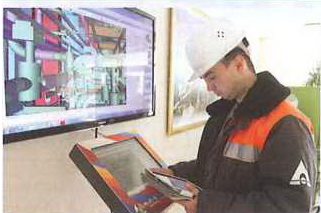 |
Articles
22 Sep 2014 Dassault Systemes, Intergraph, and NEOLANT participate in ęMulti-DĽ software project developed by a Russian nuclear power plant A software package from NIAEP-ASE aims to unite construction project design and schedule

Electrical utilities have come to plan and organize work and capital expenditure in a nuclear power plant in terms of the plantís entire life cycle. This comprehensive approach extends to the creation of a digital model of ah the processes and facilities. At the same time, it has become evident that every stage of a nuclear power plantís life cycle requires different software solutions: one for design and construction, and a separate software tool for calendar network scheduling. There is in addition a huge amount of data related to the facility.
To overcome hurdles between different software packages and to strengthen its position in the global market, Russian state nuclear power plant Ň–— organization NIAEP-ASE has been developing and actively implementing an innovative project management system for the construction of complex engineering facilities called ęMulti-DĽ.
The Multi-D technology, which is based on a three-dimensional visual model, offers a range of tools to model in detail construction and installation processes, to optimise numerous aspects of NPP construction early in preparatory stages, to review various scenarios of resources management and, if necessary, to introduce changes into the 3D model for optimization.
The core of the system consists of process and instrumentation drawings (P&IDs), three- dimensional engineering and modelling of P&IDs and civil and construction elements.
A Multi-D model comprises an intelligent spatial facility model including drawings and 3D imaging, a schedule of work performance based on production rates and physical volumes that are given in the specifications and cost of the facility construction.
Multi-D translates the schedule into a project plan shared by hundreds of workers sharing access to a computer network. Based on these schedules and current construction best practice, Multi-D applies the schedule stage-wise to installation work on elevations, rooms and installation areas.
Multi-Dís unified information model divides the process of 3D design and modelling, including of buildings and process structures, into smaller steps. After 3D models have been made, the equipment is configured to best match the rooms. Jointly, engineers and task-planners create the sequence of the equipment installation. This results in an optimised networked project schedule. Comparing details from the process equipment arrangement model with details of the available construction workforce and construction equipment inventory enable the development of daily and weekly task lists.
In practice
Currently elements of Multi-D technology are being tested on the Rostov 3 site. During the construction of Rostov 3, Multi-D demonstrated its worth. The normal construction process is of course to install a reactor vessel and then install supporting process equipment around it. But what happened was that the reactor vessel was broken.
Were the normal construction process to be followed, such a catastrophe would lead to a project delay of a year at least. But the Multi-D model demonstrated the possibility of installing reactor compartment equipment first, and then installing the replacement vessel. This made it possible to comply with the approved construction schedule. Due to the application of Multi-D technology the construction of unit 3 of Rostov NPP is planned to be completed four months ahead of schedule, saving 7% of construction time, and significant financial resources.
Multi-D technology, which has also been used in thermal power plant design and construction, continues to be developed by NIAEP-ASE with the assistance of strategic partners such as Dassault Systems (France) and Intergraph (USA). Its system integration partner is NEOLANT of Russia.
Field Engineering Tools
 Any employee in need of actual information or a personal task can download it to a tablet computer from a protected kiosk.
Also, an automated personnel monitoring system is based on an RFID transmitter built into the hard hat of every employee. The transmitter informs the construction manager of the location of personnel at any particular moment.
Virtual rooms have been installed at construction facilities to view a 3D model of a facility/unit/equipment, to reconstruct the sequence of the installation, to discuss possible options with the management and colleagues.
Another tool enables a manager to compare the as-built condition of the structure with plans. The plan is displayed as a spherical composite picture taken from various angles to ensure total coverage of all the construction areas and corresponding views from the 3D model. The manager can select any camera position and determine whether there are any deviations from the design.
Any employee in need of actual information or a personal task can download it to a tablet computer from a protected kiosk.
Also, an automated personnel monitoring system is based on an RFID transmitter built into the hard hat of every employee. The transmitter informs the construction manager of the location of personnel at any particular moment.
Virtual rooms have been installed at construction facilities to view a 3D model of a facility/unit/equipment, to reconstruct the sequence of the installation, to discuss possible options with the management and colleagues.
Another tool enables a manager to compare the as-built condition of the structure with plans. The plan is displayed as a spherical composite picture taken from various angles to ensure total coverage of all the construction areas and corresponding views from the 3D model. The manager can select any camera position and determine whether there are any deviations from the design.
See also:
Permanent link :: http://isicad.net/articles.php?article_num=17207

|
 |